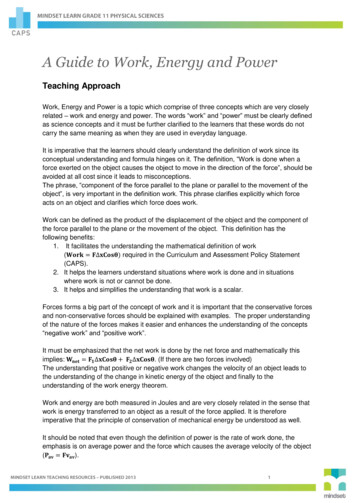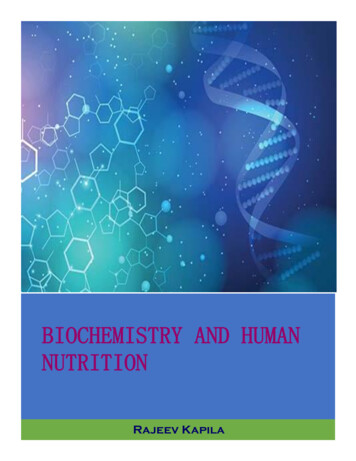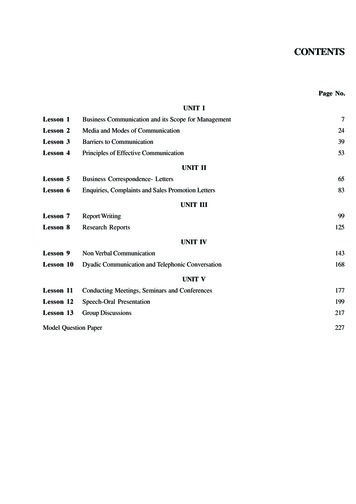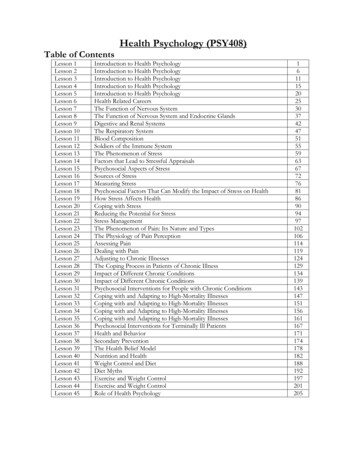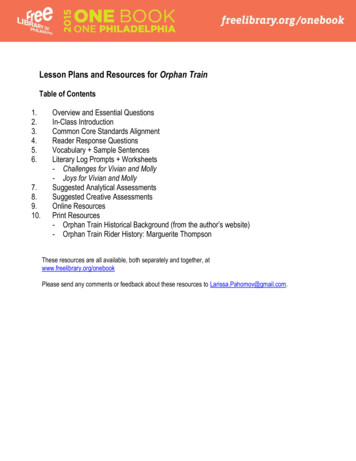
Transcription
Lesson Plans and Resources for Orphan TrainTable of Contents1.2.3.4.5.6.7.8.9.10.Overview and Essential QuestionsIn-Class IntroductionCommon Core Standards AlignmentReader Response QuestionsVocabulary Sample SentencesLiterary Log Prompts Worksheets- Challenges for Vivian and Molly- Joys for Vivian and MollySuggested Analytical AssessmentsSuggested Creative AssessmentsOnline ResourcesPrint Resources- Orphan Train Historical Background (from the author’s website)- Orphan Train Rider History: Marguerite ThompsonThese resources are all available, both separately and together, atwww.freelibrary.org/onebookPlease send any comments or feedback about these resources to Larissa.Pahomov@gmail.com.
OVERVIEW AND ESSENTIAL QUESTIONSThe materials in this unit plan are meant to be flexible and easy to adapt to your own classroom. Eachchapter has discussion questions provided in a later section.Through reading the book and completing any of the suggested activities, students can achieve anynumber of the following understandings:-There are both permanent and changeable parts of a person’s identity.Humans are influenced by both the joys and challenges they have experienced.People cannot survive without some kind of connection to others.Students should be introduced to the following key questions as they begin reading. They can be discussedboth in universal terms and in relation to specific characters in the book:Universal-What do children need to survive? How about to really thrive in the world?What parts of a person’s identity can be changed? Which parts can never be changed?What has a greater influence on a person: the joys they have experienced, or the challenges?Book-Specific-Did Vivian get what she needed to survive? How about Molly?Is Vivian the same person as Niamh? In what ways?Was Vivian made into her current self because of the hardships she endured, or because ofthe kindness and joys she found along the way? How about Molly?Many of the reader response questions and suggested projects relate to these essential questions, andthey can be looped back to frequently.
IN-CLASS INTRODUCTIONThis lesson is designed to provide students with a one-class introduction to the book. The lesson can beused to start off a class reading of the text, or to encourage them to read it independently.As a recipient of One Book resources, the Free Library requires that you devote one class period tointroducing Orphan Train to students, either using this lesson or your own plan.Introduction1. Have students brainstorm, verbally or on paper:Who are your ghosts?Discuss that the ghosts in their life may not be people who have passed away – they can be peoplethat they have lost contact with, or have left them in some way.2. Distribute books and read the prologue together. Discuss:a. Who might this person be? What clues do “gram” and “da” and “ma” give?b. Is she or he “lucky” for having these ghosts?c. Do you agree with the line that ghosts can “console and protect me in death as they neverdid in life.” Can somebody play a stronger role in their absence than they can in theirpresence?3. Now, have students partner up and read different short chapters, introducing them to the two maincharacters. One student reads about Molly (pages 3-10) and one student reads about Niamh (pgs19-23). When they are finished, discuss: what did you learn about your individual? Who might theirghosts be?4. Hand out a reading log and/or vocabulary list as needed, and then give students time to continuereading on their own.5. If students have internet access: have them visit the “virtual tenement tour” on the New YorkTenement Museum website: http://www.tenement.org/Virtual Tour/index virtual.html
Correlation to Common Core Standards for Grades 11-12INTRODUCTION LESSON DISCUSSION QUESTIONSReading Standards for Literature1. Cite strong and thorough textual evidence to support analysis of what the text says explicitly as well asinferences drawn from the text, including determining where the text leaves matters uncertain.2. Determine two or more themes or central ideas of a text and analyze their development over the courseof the text, including how they interact and build on one another to produce a complex account; provide anobjective summary of the text.10. By the end of grade 11, read and comprehend literature, including stories, dramas, and poems, in thegrades 11–CCR text complexity band proficiently, with scaffolding as needed at the high end of the range.By the end of grade 12, read and comprehend literature, including stories, dramas, and poems, at the highend of the grades 11–CCR text complexity band independently and proficientlySpeaking and Listening Standards1. Initiate and participate effectively in a range of collaborative discussions (oneon-one, in groups, andteacher-led) with diverse partners on grades 11–12 topics, texts, and issues, building on others’ ideas andexpressing their own clearly and persuasively.2. Integrate multiple sources of information presented in diverse formats and media (e.g., visually,quantitatively, orally) in order to make informed decisions and solve problems, evaluating thecredibility and accuracy of each source and noting any discrepancies among the data.VOCABULARYReading Standards for Literature4. Determine the meaning of words and phrases as they are used in the text, including figurative andconnotative meanings; analyze the impact of specific word choices on meaning and tone, including wordswith multiple meanings or language that is particularly fresh, engaging, or beautiful.Language Standards4. Determine or clarify the meaning of unknown and multiple-meaning words and phrases based on grades11–12 reading and content, choosing flexibly from a range of strategies.6. Acquire and use accurately general academic and domain-specific words and phrases, sufficient forreading, writing, speaking, and listening at the college and career readiness level; demonstrateindependence in gathering vocabulary knowledge when considering a word or phrase important tocomprehension or expression.ANALYTICAL CREATIVE ASSESSMENTSWriting Standards1. Write arguments to support claims in an analysis of substantive topics or texts, using valid reasoning andrelevant and sufficient evidence.3. Write narratives to develop real or imagined experiences or events using effective technique, wellchosen details, and well-structured event sequences4. Produce clear and coherent writing in which the development, organization, and style are appropriate totask, purpose, and audience. (Grade-specific expectations for writing types are defined in standards 1–3above.)
5. Develop and strengthen writing as needed by planning, revising, editing, rewriting, or trying a newapproach, focusing on addressing what is most significant for a specific purpose and audience. (Editing forconventions should demonstrate command of Language standards 1–3 up to and including grades 11–12on page 54.)9. Draw evidence from literary or informational texts to support analysis, reflection, and research.
READER RESPONSE QUESTIONSSection 1 – Pages 1-23Who is speaking in the prologue? What role did the ghosts play in their life?What are the basics of Molly’s situation? Do you sympathize with her?Section 2 – Pages 24-55Dutchy has a very particular idea about the orphan train and what will happen to the kids on it. Do youagree with him?Why does Vivian have so much stuff? And why does she avoid modern technology?Section 3 – Pages 56-82In her placement with Mrs. Byrne, Niamh gets the advice that “you got to learn to take what people arewilling to give.” (77) Do you think this is good advice? What might the downsides be?Section 4 – Pages 83-112Why does Vivian pry into the details of Molly’s life? Why does Molly react to that the way that she does?Who do you think is in the right?Why do you think Mr. and Mrs. Byrne act the way that they do? Is her behavior – and especially his –excusable in the name of trying to survive?How has Niamh/Dorothy changed her own behavior or her identity to survive? At the end of the section,she says she feels that she is “retreating” (112). Is this healthy or dangerous?Section 5 – Pages 113-138How do the Grotes compare to the Brynes? Has Niamh’s/Dororthy’s situation improved or gotten worse?Why does Molly wear a nose ring? Why isn’t she in a hurry to put it back in? What might this reveal abouther changing mindset?What choice does the social worker present to Molly?What’s the assignment given to Molly in school? In what ways does the assignment relate to Vivian – andto Molly?Section 6 – Pages 139-167
Why does Niamh/Dorothy avoid telling Miss Larsen what’s wrong at home?Why does Miss Larsen choose to intervene, even when she said earlier she can’t take a child home withher?Section 7 – Pages 169-199Why does Vivian reference Macbeth when her stories start pouring out of her? “Who would have thoughtthe old man to have so much blood in him?” Why is her telling the story of her life like killing a person?Why did the “experience of emotion” (170) stop coming naturally to Vivian?Why does Molly speak up in the defense of Native Americans in class? How does it go?Why does Molly snap at Jack when he questions what’s she’s up to with Vivian (174)? Why does hiscomment get to the heart of her life situation?Vivian says that the first 23 years of her life are the ones that shaped her – and the rest of them areirrelevant. Do you think a person can actually experience their life in this way?Why does Niamh/Dorothy agree to take the name Vivian? Do you agree with her choice?Section 8 – Pages 200-236Why does Vivian decide to avoid getting in trouble with the Nielsens? In what way does this make herdifferent from other teens her age?What finally makes Molly decide to pack up and leave? Why can’t Ralph talk her out of it? How does hecompare to Mr. Byrne?Why do you think Molly decides to reveal to Vivian that her sister Maisie was alive all of these years?Why is Vivian so comfortable around Dutchy, despite the fact that she has practically no romanticexperience?Section 9 – Pages 237-273After Dutchy dies, Vivian says that she’s learned what it is to lose everything, and that “it must be my lot inlife to be taught that lesson over and over again.” Do you agree with her viewpoint on fate?Do you think Vivian makes the right choice in giving away her daughter?Why do you think Vivian opens herself up to technology and contact at the very end of the story?
Reading Group Guide Questions (provided by the publisher)1. On the surface, Vivian’s and Molly’s lives couldn’t be more different. In what ways are their storiessimilar?2. In the prologue Vivian mentions that her “true love” died when she was 23, but she doesn’t mention theother big secret in the book. Why not?3. Why hasn’t Vivian ever shared her story with anyone? Why does she tell it now?4. What role does Vivian’s grandmother play in her life? How does the reader’s perception of her shift asthe story unfolds?5. Why does Vivian seem unable to get rid of the boxes in her attic?6. In Women of the Dawn, a nonfiction book about the lives of four Wabanaki Indians excerpted in theepigraph, Bunny McBride writes: “In portaging from one river to another, Wabanakis had to carry theircanoes and all other possessions. Everyone knew the value of traveling light and understood that itrequired leaving some things behind. Nothing encumbered movement more than fear, which was often themost difficult burden to surrender.” How does the concept of portaging reverberate throughout this novel?What fears hamper Vivian’s progress? Molly’s?7. Vivian’s name changes several times over the course of the novel: from Niamh Power to Dorothy Nielsento Vivian Daly. How are these changes significant for her? How does each name represent a differentphase of her life?8. What significance, if any, does Molly Ayer’s name have?9. How did Vivian’s first-person account of her youth and the present-day story from Molly’s third-personlimited perspective work together? Did you prefer one story to the other? Did the juxtaposition reveal thingsthat might not have emerged in a traditional narrative?10. In what ways, large and small, does Molly have an impact on Vivian’s life? How does Vivian have animpact on Molly’s?11. What does Vivian mean when she says, “I believe in ghosts”?12. When Vivian finally shares the truth about the birth of her daughter and her decision to put May up foradoption she tells Molly that she was “selfish” and “afraid.” Molly defends her and affirms Vivian’s choice.How did you perceive Vivian’s decision? Were you surprised she sent her child to be adopted after her ownexperiences with the Children’s Aid Society?13. When the children are presented to audiences of potential caretakers, the Children’s Aid Societyexplains adoptive families are responsible for the child’s religious upbringing. What role does religion playin this novel? How do Molly and Vivian each view God?
14. When Vivian and Dutchy are reunited she remarks, “However hard I try, I will always feel alien andstrange. And now I’ve stumbled on a fellow outsider, one who speaks my language without saying a word.”How is this also true for her friendship with Molly?15. When Vivian goes to live with the Byrnes Fanny offers her food and advises, “You got to learn to takewhat people are willing to give.” In what ways is this good advice for Vivian and Molly? What are someinstances when their independence helped them?16. Molly is enthusiastic about Vivian’s reunion with her daughter, but makes no further efforts to see herown mother. Why is she unwilling or unable to effect a reunion in her own family? Do you think she willsomeday?17. Vivian’s Claddagh cross is mentioned often throughout the story. What is its significance? How does itsmeaning change or deepen over the course of Vivian’s life?
VOCABULARYSection 1 – Pages 1-23Void (20) – It was so dark that I wondered, as I had many times before, if this is what blindness felt like—this enveloping void.Wan (22) – Mr. Kaminski pulled a chain from the pressed-metal kitchen ceiling, and light seeped from abulb, casting a wan glow over a scarred wooden table Incessant (23) – I was so afraid that our lives would fall apart again that I tried to ignore the things thatfrightened me the most: our da’s continued love affair with drink, which a change in country did not change;Mam’s black moods and rages; the incessant fighting between them.Section 2 – Pages 24-55Superlative (25) – Yes, he says “perfect,” parr-fec, in his German accent; I learn, in this instant, the terriblepower of superlatives.Milquetoast (28) – Mrs. Scatcherd and Mr. Curran, a milquetoast with a brown moustache, line us up byheight, tallest to shortest Surreptitious (52) – Glancing surreptitiously at her phone, Molly sees it’s 4:15—only fifteen minutes sinceshe arrived.Genteel (53) – That she has fulfilled her role as a thieving member of the underclass, now indentured tothis genteel Midwestern white lady, is too perfect for words.Section 3 – Pages 56-82Depravity (64) – “You have the chance to save a child from destitution, poverty, and I believe Mrs.Scatcherd would agree that it is not too great an exaggeration to add sin and depravity.”Florid (69) – Mr. Curran gives a less florid version of the speech he gave in Minneapolis, and people beginto inch forward.Tufted (77) – At the back of the yard, tufted with grass like spare hair on a balding head, is a weatheredgrey shed with a slit cut out of the door.Austere (81) – The house is austere, but not uncomfortable.Section 4 – Pages 83-112Apropos (85) – At one point, apropos of nothing, Vivian says, “So where is that mother of yours, anyway?”
Rescind (93) – “He should know fully what sort of a bargain he had made, while there was time to rescindit.”Insolent (96) – “You insolent girl. I don’t want to hear another word.”Desiccated (106) – We’ve stopped eating dinner together. She takes her food upstairs, leaving adesiccated chicken leg or a bowl of cold brisket in a chunk of brown gelatinous fat on the counter, with strictinstructions that I wash my dish when I’m done.Section 5 – Pages 113-138Gingerly (114) – Mr. Sorenson rubs his hands together and, motioning for me to follow, makes his waygingerly up the creaking steps to the porch.Contemporaneous (131) – They’ve read Native narratives and contrasting contemporaneous viewpointsand taken a field tripe to the Abbe, the Indian musem in Bar Harbor Scant (132) – Molly’s own childhood memories are scant and partial.Emanating (137) – It was pouring earlier, great sheets of frain, and now the clouds outside the window arecrystal tipped, like mountain peaks in the sky, rays emanating downward like an illustration in a children’sbible.Section 6 – Pages 139-167Remnant (142) – I sat on a three-legged stool listening to the crackle and spit of goose skin in the ovenwhile she trims a ribbon of dough from around the rim of the pie dish, making a cross with a remnant for thecenter and brushing it all with a beaten egg Haphazard (148) – By mid-September, round bales of golden straw dot the yellow fields on my walk to thecountry road, arranged in geometric formations stacked in pyramids and scattered in haphazard clumps.Salvage (153) – My coat is thin, but I’m wearing what clothing I could salvage underneath, and as I hurryalong I begin to warm up.Inadvertently (158) – I merely meant that sometimes, particularly if one has been through distressingevents in one’s young life, one might be inclined to jump to conclusions—to inadvertently blow things out ofproportion.Section 7 – Pages 169-199Insubordination (182) – “The predicament, you must understand, is that you are an orphan, and thatwhatever the reality, it looks as there may be an issue with insubordination.”Quivering (187) – The other three adults watch us with a quivering intensity.Elemental (195) – We light candles the twenty-foot tree to the right of the altar, all the fair-haired Lutheran
children and parents and grandparents singing with songbooks open, the reverend preaching a semon aselemental as a story in a child’s picture book, a lesson about charity and empathy.Section 8 – Pages 200-236Reprobation (202) – The only thing they can really take away is my weekly Sunday-afternoon trip to thepicture show with Judy, so for the next two weeks I stay home instead. And endure their silent reprobation.Revelation (204) – And when I begin to wear makeup, I have a revelation.Placate (205) – Together we manage employee’s problems, placate customers, manage vendors.Pusillanimous (209) – She almost feels sorry for him, the pusillanimous wretch.Sycophantic (218) – Once upon a time—fairly recently, in fact—Molly would’ve gagged over these words,both because they’re blatanly sycophantic and cringingly sentimental.Section 9 – Pages 237-273Languorous (238) – I have never felt like this—slow-witted and languorous, dreamy, absentminded,forgetful, focused only on each moment as it comes.Parse (242) – I listen to the radio, scour the Tribune, wait anxiously for the mail drop, and devour Dutchy’sletters when they come, scanning quickly for news—is he okay? Eating well, healthy?—and parsing everyword for the tone and nuance, as if his sentences are a code I can crack.Idiom (243)—The words he uses are the idioms of popular songs and poems in the newspaper.Amicable (258) – In the window in Molly’s bathroom, also on the ocean side, a light cotton curtain dancesconstantly in the breeze, sucked toward the screen and out again, billowing towards the sink, an amiableghostly presence.
Challenges for Vivian and MollyName:Both Niamh/Vivian and Molly encounter several challenges during their childhood. When you discover onein the text, write it down along with who it happened to. Then describe what effect it had on their identity.Name of character, challenge, page #Analysis: what effect did it have on them?
Joys for Vivian and MollyName:Both Niamh/Vivian and Molly also have a series of positive experiences during their childhoods. When youencounter one in the text, write it down, along with an analysis of what positive effect that encounter had.Positive encounter, character, page #Analysis – what effect did it have on them?
SUGGESTED ANALYTICAL ASSESSMENTSThese prompts could be used for traditional essay assignments, or for responses across a variety ofmediums (live presentation, digital stories via Powerpoint or video, etc.)1. In a description of her motivation for writing the novel, author Christina Baker Kline explains:I am interested in exploring how people tell the stories of their lives and what these stories reveal(intentionally or not) about who we are. I am intrigued by the spaces between words, the silences thatconceal long-kept secrets, the elisions that belie surface appearance. And I am interested in the pervasiveand insidious legacy of trauma – the way events beyond our control can shape and define our lives. All ofmy books address these themes. /)In what ways does “Orphan Train” achieve what she is describing? Pick one or more items that shenotes as being present and give specific examples from the book.2. Choose one narrative from a real orphan train rider to read and compare to the story of Vivian. How dothe stories compare and contrast? What common thread do they have? ies/3. This book was selected by Philadelphia as a novel that would interest readers across the city, of differentages and backgrounds. Do you agree with this assessment? Write a letter to libraries in other citiespresenting an argument either for or against adopting the novel for their own programs. Cite specificexamples from the text with direct quotes to show why this book does or does not have a universal appealto readers.
SUGGESTED CREATIVE ASSESSMENTSThese prompts could be used for traditional essay assignments or for responses across a variety ofmediums (live presentation, digital stories via powerpoint or video, etc.)1. The assignment from the book! Interview someone—a mother or father or grandparent (or anotherelder)—about their own portages, the moments in their lives when they’ve had to take a journey,literal or metaphorical. Record the interviews and conduct “oral analyses,” asking the personquestions, transcribing their answers, and putting it together in chronological order as a narrative.The question to focus on are:a. What did you choose to bring with you to the next place?b. What did you leave behind?c. What insights did you gain about what’s important?Students can create an edited audio version of the final product if the technology is available tothem; otherwise, it can be transcribed into a narrative essay.2. The book switches between the narratives of Vivian and Molly, but leaves out large chunks ofmany other characters and their history. Pick one of the characters we are missing informationabout – Dutchy, Vivian’s sister Maisie, the baby Carmine, or Vivian’s daughter Sarah – and fill intheir own story, writing in either the first or third person.3. Though their methods were questionable, the adults who organized the Orphan Trains – and thepeople who adopted from them – often had an honest desire to help children in need. Pick oneadult from the book – Mrs. Scatcherd, Mr. or Mrs. Schatzman, Miss Larsen, or Mr. or Mrs. Nielsen - and write a letter from their perspective, explaining their actions to a friend or family member.What motivated them to become involved? Did they feel that anything they were doing was wrong?If yes, how did they rationalize it? If no, why not?
ONLINE RESOURCESFROM THE AUTHOROrphan Train Book ClubA treasure trove of information and links relating to Orphan Train – from which many of the other links onthis page are DIONPR InterviewSeven minutes with the author discussing some of the historical intrigue and surprises during her inVIDEOPBS Documentary: The Orphan TrainsInformation about the American Experience -Second “Book Trailer” for Orphan TrainA preview without spoilers.https://www.youtube.com/watch?v JmgbE6I9HnwChristina Answer the top 10 book club questionsA 15-minute video with questions about her process and choices for writing the book.https://www.youtube.com/watch?v 4zVe698daTEHISTORY“Orphan Train” Historical BackgroundA short personal essay from the author that explains the context of the book, as well as her ownmotivations and interests in exploring this novel/Children’s Aid Society HistoryA book review that gives a detailed explanation of the history and intentions of the group that put childrenon the or-01orphan.htmlNational Orphan Train ComplexAdvocacy group preserving the history of Orphan trains.http://orphantraindepot.org/
Orphan Train Rider StoriesWritten testimonials from riders who were sent in the 1900’s, 1910’s, and rider-stories/PRINT RESOURCESOrphan Train Historical BackgroundI am interested in exploring how people tell thestories of their lives and what these stories reveal(intentionally or not) about who we are. I amintrigued by the spaces between words, the silencesthat conceal long-kept secrets, the elisions that beliesurface appearance. And I am interested in thepervasive and insidious legacy of trauma – the wayevents beyond our control can shape and define ourlives. All of my books address these themes.Like my four previous novels, my novel Orphan Train is about cultural identity and family history. For thefirst time, however, I am undertaking a project that requires a large amount of historical, cultural, andgeographical research. My novel traces the journey of Vivian Daly, a now-90-year-old woman, from a smallvillage in Ireland to the crowded streets of the Lower East Side to the wide-open expanses of the Midwestto the coast of Maine. Her life spans nearly a century, encompassing great historical change and upheaval.Change has been the defining principle of Vivian Daly’s life, and from a very young age she learned toadapt, to inhabit new identities. For many reasons, she has told no one about her early life: her difficultchildhood in Ireland and the lies and secrets thatpropelled her, alone, toward a frighteningly openended future. She spent her entire adult life minimizingrisk, avoiding complicated entanglements, and keepingsilent about the past. But now, through a series ofevents, she encounters a stranger who wants to knowher story. As Vivian begins to face the truth about whathappened long ago, the past becomes more and morepresent for her. Vivian’s recollections come in tiers: herturbulent adulthood in the Midwest; her early life on theLower East Side of Manhattan, living in a tenement;and finally, her childhood in Kinvara, on the westerncoast of Ireland.Orphan Train is a specifically American story ofmobility and rootlessness, highlighting a little-known but historically significant moment in our country’spast. Between 1854 and 1929, so-called “orphan trains” transported more than 200,000 orphaned,abandoned, and homeless children – many of them first-generation Irish Catholic immigrants – from the
coastal cities of the eastern United States to the Midwest for “adoption” (often, in fact, indenturedservitude). Charles Loring Brace, who founded the program, believed that hard work, education, and firmbut compassionate childrearing – not to mention Midwestern Christian family values – were the only way tosave these children from a life of depravity and poverty.The children, many of whom had experienced great trauma in their short lives, had no idea where therewere going. The train would pull into a station, and townspeople assembled to inspect them – often literallyscrutinizing teeth, eyes, and limbs to determine whether a child was sturdy enough for field work orintelligent and mild-tempered enough to cook and clean. Babies and healthy older boys were typicallychosen first; older girls were chosen last. After abrief trial period, the children became indentured totheir host families. If a child wasn’t chosen, he orshe would get back on the train to try again at thenext town.Some children were welcomed by new familiesand towns. Others were beaten, mistreated,taunted, or ignored. They lost any sense of theircultural identities and backgrounds; siblings wereoften separated, and contact between them wasdiscouraged. City children were expected toperform hard farm labor for which they wereneither emotionally nor physically prepared. Manyof them, first-generation immigrants from Italy,Poland, and Ireland, were teased for their strange accents; some barely spoke English. Jealousy andcompetition in the new families created rifts, and many children ended up feeling that they didn’t belonganywhere. Some drifted from home to home to find someone who wanted them. Many ran away. TheChildren’s Aid Society did attempt to keep track of these children, but the reality of great distances andspotty record-keeping made this difficult.I became interested in the story of the orphan trains because my husband’s grandfather, Frank Robertson,was rumored to have been a train rider. It was believed that he traveled on an orphan train from New Yorkto Jamestown, North Dakota with his four siblings when he was ten years old. In the course of researchingthis family lore, I found that although orphan trains did, in fact, stop in Jamestown, and orphans from thesetrains were adopted there, the Robertson clan came from Missouri. But my interest was piqued, and Istarted researching this period in history.After reading newspaper clippings, I began searching the Web for mor
Lesson Plans and Resources for Orphan Train Table of Contents 1. Overview and Essential Questions 2. In-Class Introduction 3. Common Core Standards Alignment 4. Reader Response Questions 5. Vocabulary Sample Sentences 6. Literary Log Prompts Worksheets - Chall








